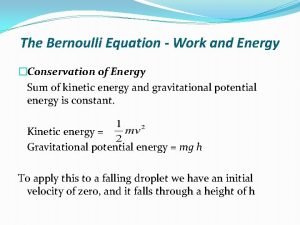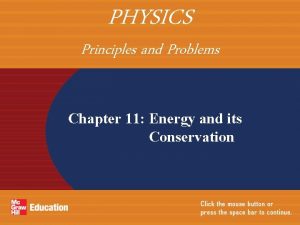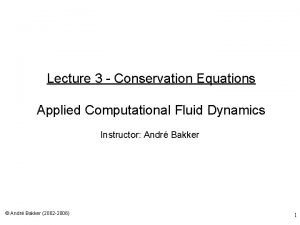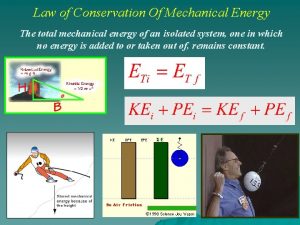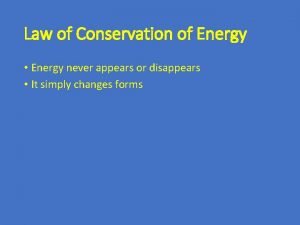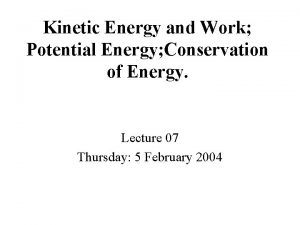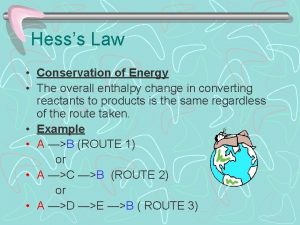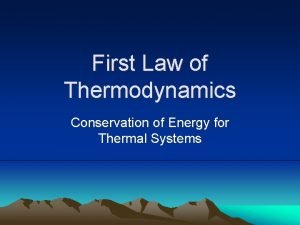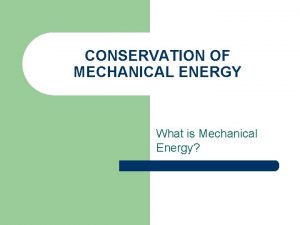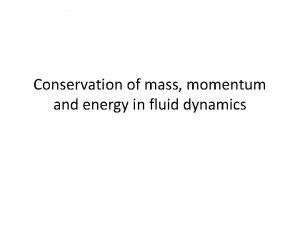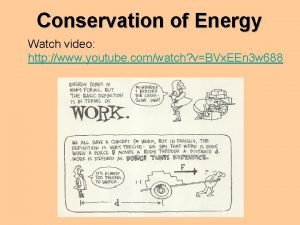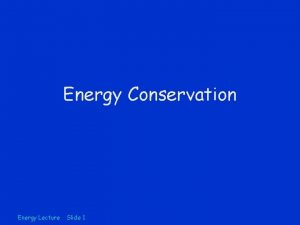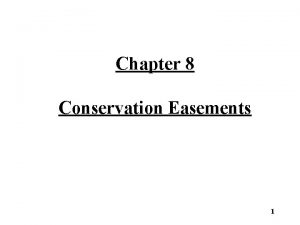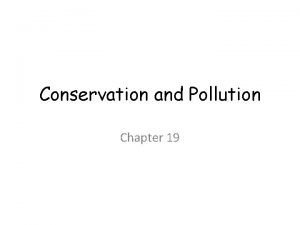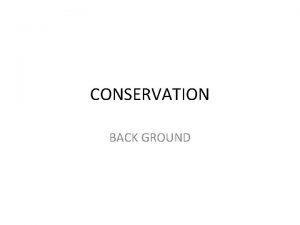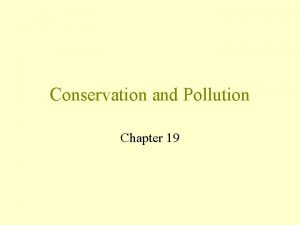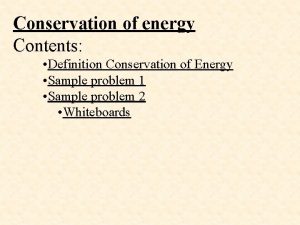Conservation of Energy Conservation of Energy Energy can

















- Slides: 17

Conservation of Energy

Conservation of Energy • Energy can neither be created nor destroyed. But it can be transferred from one type to another (i. e. potential to kinetic) in a closed system.

Examples… The ball is losing height (falling – h is decreasing) and gaining speed (v is increasing). Energy is transformed from PE (height) to KE (speed). Motion - A ball falls from a height of 2 meters in the absence of air resistance.

Examples… Motion - A skier glides from location A to location B across a friction free ice. The skier is losing height (the final location is lower than the starting location) and gaining speed (the skier is faster at B than at A). Energy is transformed from PE (height) to KE (speed).

Examples… The ball is gaining height (rising) and losing speed (slowing down). Energy is transformed from KE (speed) to PE (height). Motion - A baseball is traveling upward toward a man in the bleachers.

Examples… The jumper is losing speed (slowing down) and the bungee cord is stretching. Energy is transformed from KE (speed) to PE (a stretched "spring"). Motion - A bungee cord begins to exert an upward force upon a falling bungee jumper.

Examples… Motion - The spring of a dart gun exerts a force on a dart as it is launched from an initial rest position. The spring changes from a compressed state to a relaxed state and the dart starts moving. Energy is transformed from PEs (a compressed spring) to KE (speed).

Closed System? • A closed system is one in which there are no external forces doing work on the system, and no transfer of energy into or out of the system. • External Forces- FA, Ff, FT, Fair, FN • The total energy (ET) of a closed system ALWAYS remains the same.

Total Mechanical Energy • In a closed (ideal) system… ΔPE + ΔKE = TME and ΔPE + ΔKE = 0 ΔKE = - ΔPE

• In a non-ideal system there is an external force acting on the system and the total energy is… internal energyinfluenced by heat ET = PE + KE + Q Here’s the equation we’re going to use: W = ΔPE + ΔKE + Wf

A 10 kg v=0 There are 3 different approaches we can take to solve this problem: 1. 20 m PE = KE’ mgh = 1 mv 2 2 2 mgh = 1 mv 22 2 2 mgh = mv 2 m m v 2 = 2 gh B v = ? 20 m/s v 2 = 2(10 m/s 2)(20 m) v 2 = 400 m/s

A 10 kg v=0 2. 0 0 W = ΔKE + ΔPE + Wf Any work being done on the system (W = Fd)? Is anyone Any friction? pulling or pushing on the block? 20 m No – neglecting No air friction 0 = ΔKE + ΔPE 0 0 0 = KEf – KEi + PEf – PEi 0 = KEf – PEi KEf = PEi B v=?

A 10 kg v=0 20 m B v=? 3. A B KE 0 ½ mv 2 = 2000 J PE mgh= 2000 J PEs 0 0 0 Wf 0 0 v 2 = 2 gh = 20 m/s TE 2000 J

10 kg v=0 How could we of figured this out without energy? vi = 0 m/s a = 10 m/s 2 20 m d = 20 m vf = ? vf 2 = vi 2 + 2 ad v = ? 20 m/s vf 2 = 2 ad vf 2 = 2(10 m/s 2)(20 m) vf 2 = 400 m/s

A B C KE = TE – PE = 1320 J 0 PE ½ mv 2 = 1920 J 0 mgh = 600 J h = PE/mg = 3. 2 m PEs 0 0 0 8 m/s v 2 = 2 KE/m = 6. 6 m/s 0 m/s 1920 J KE Wf v TE 1920 J h=? v = 0 m/s C B A Remember energy is another way of analyzing motion.


This time there is Wf. Friction is stopping the ball. W = ΔKE + ΔPE + Wf W f = F fd v = 30 m/s Wf = µmgd A 10 kg 45 m B d = Wf µmg C µ =. 1 d=? v = 0 m/s
 Chapter 7 energy conservation of energy
Chapter 7 energy conservation of energy Work energy theorem
Work energy theorem Final potential energy
Final potential energy Ball a has half the mass and eight times
Ball a has half the mass and eight times Chapter 11 study guide conservation of energy
Chapter 11 study guide conservation of energy Derive the equation of kinetic energy
Derive the equation of kinetic energy Law of mechanical energy
Law of mechanical energy Law of conservation of energy worksheets
Law of conservation of energy worksheets Work and potential energy
Work and potential energy Principle of conservation of energy
Principle of conservation of energy First law of td
First law of td Boiler efficiency direct method
Boiler efficiency direct method Mechanical energy definition
Mechanical energy definition Fluid
Fluid Energy conservation law
Energy conservation law Conservation of energy youtube
Conservation of energy youtube The law of conservation of energy states that
The law of conservation of energy states that Law of conservation of energy examples
Law of conservation of energy examples


